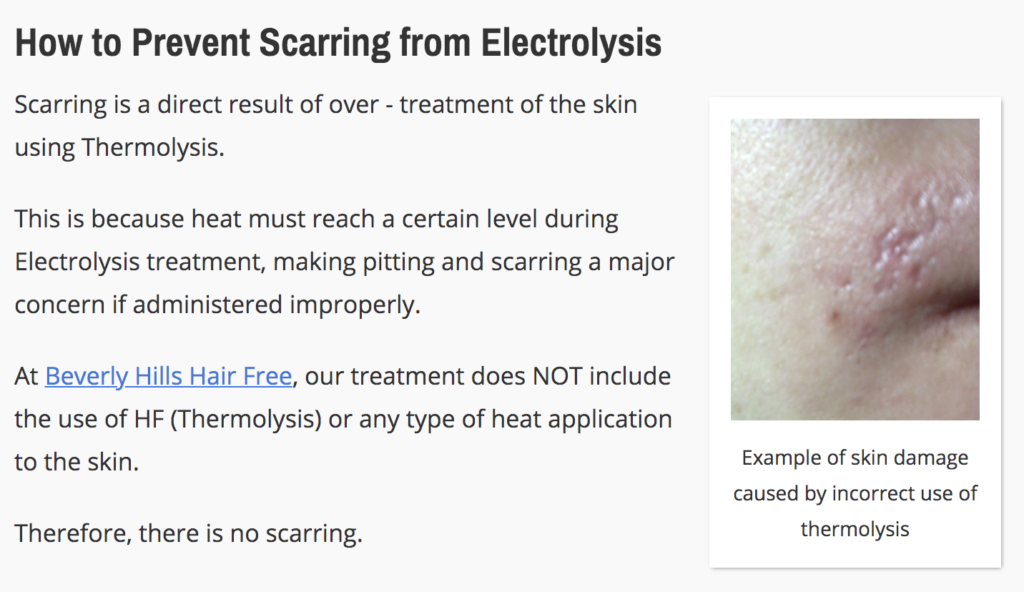Galvanic electrolysis is the oldest form of electrolysis, having been developed by Dr. Charles Michel, a St. Louis ophthalmologist, in 1875. Since then, the term “electrolysis” evolved into a general term encompassing several different types of hair removal. However, in the word’s original scientific sense, it refers solely to a modality known as galvanic electrolysis. I only use traditional galvanic electrolysis, as I find it to be the most reliable and least damaging method to permanently remove hair.
How does galvanic electrolysis work?
To treat a hair, your electrologist will painlessly slide a thin stainless-steel filament alongside the hair shaft into the follicle. This filament is commonly referred to as a needle, although many technicians prefer the term probe, as the former falsely implies that the skin is being pierced. A voltage is applied, resulting in the formation of lye along the length of the needle. This lye dissolves the follicular epithelium, destroying the cells at the base of the follicle responsible for the hair’s growth and regeneration. The hair is then removed with tweezers and discarded.
How much energy does it take to kill a hair?
In order to discuss the intensity of galvanic treatment, we need to speak the same language. Galvanic operators generally speak in terms of units-of-lye. A unit-of-lye (UL) is the amount of lye formed from a current of 0.1 milliampere over the course of 1 second. Arthur Hinkel proposed this ad hoc measuring system while developing a methodology for setting blend currents, and it remains in use today. The amount of lye needed to kill a hair ranges from about 15 UL for wispy, vellus hairs to about 90 UL for deep, coarse pubic hair. It is generally useful to keep in mind that these numbers are rough guidelines; the amount of lye it takes to kill a hair is simply the amount of lye it takes to kill a hair. That being said, these numbers are generally in the ballpark, and Hinkel himself asserted that they were generally a little higher than they needed to be. (Hinkel & Lind, 1968)
Why can’t I find a galvanic operator near me?
There are very few electrologists practicing today who use single-needle galvanic electrolysis. Many electrologists will tell you that galvanic electrolysis is both too slow and too painful to be of any practical use today. This conventional wisdom has arisen not from any hands-on experience with galvanic electrolysis, but rather, in part, from clients chattering on Reddit and, in part, as received knowledge passed down from thermolysis operators. It is unfortunate that galvanic electrolysis is not taught in electrolysis schools beyond the minimum amount required to satisfy the governing cosmetology board’s requirements. In the case of my own schooling in California, that amounted to 40 hours of galvanic work, supervised by instructors who solely do thermolysis.
Isn’t galvanic electrolysis slow?
Do a cursory Google search, and you’ll find many electrologists claiming that galvanic electrolysis takes up to three minutes to kill a hair.

These electrologists are conflating single-needle electrolysis with multi-needle electrolysis, in which (typically) 16 needles are used simultaneously at very low currents. It is true that each individual needle may take three minutes to kill a hair, but multiple hairs are being killed at once. I speak from personal experience: the thickest hairs on my neck took 13 seconds at a level of 0.7 mA, or 91 units of lye, to kill. A more typical timeframe is between 5 seconds and 10 seconds per hair, comparable with blend electrolysis.
Is it true that galvanic electrolysis won’t scar?
There is a misconception that it is difficult, if not impossible, to get scars from galvanic electrolysis. How I wish that this were true! I believe that this mistaken notion ultimately stems from the reputation of a prominent galvanic operator, Susan Laird. She was perhaps the only single-needle galvanic operator working in the 1990s, and she published a website documenting the thermolysis scars she was seeing on trans women in the Bay Area. As her website grew in popularity, so did the niche demand for galvanic electrolysis. Over time, the assertion that it is quite easy to scar with thermolysis has mutated into the assertion that it is nearly impossible to scar with galvanic electrolysis.

In fact, permanent marks from galvanic electrolysis have been documented as far back as the 19th century! (Bowen, 1892)
Overtreatment from galvanic electrolysis results in punctate, hypopigmented scars (i.e., little white dots). They tend to be flat and supple, occasionally presenting a pebbly texture. I have hundreds of these scars from incompetent practitioners, and I consider them in more detail in my discussion of multi-needle electrolysis. The typical response that inept electrologists give when presented with their deplorable handiwork is “Your skin takes two years to fully recover.” That’s electrologist jargon for “I fucked up, and I hope you see another electrologist so I have plausible deniability.” I still wear my marks years later. Caveat emptor.